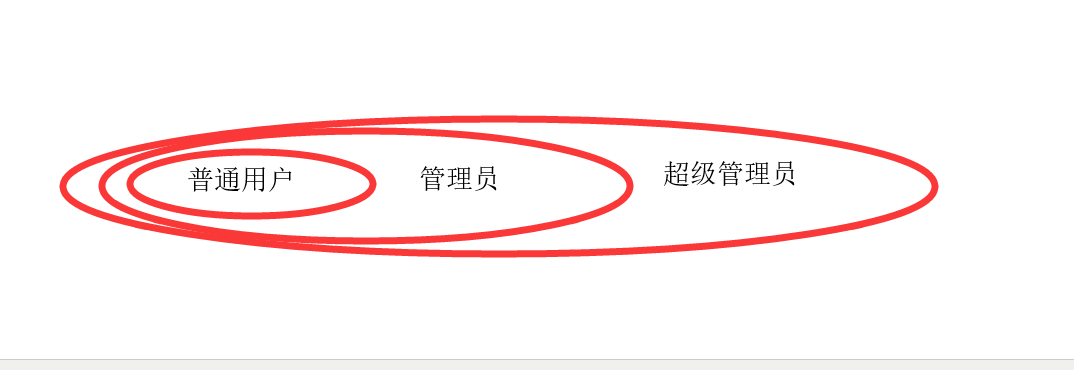1、首先定义三种用户类型:普通用户、管理员、超级管理员,不同用户类型的用户权限关系如下:

先看一段代码:
1 class Scope(): # 定义一个基类,因为每个权限类都需要add()方法 2 allow_api = [] 3 4 def add(self, other): 5 self.allow_api = self.allow_api + other.allow_api 6 return self 7 8 9 class UserScope(Scope): # 普通用户权限 10 allow_api = ['权限A'] 11 12 13 class AdminScope(Scope): # 管理员权限(管理员权限=管理员权限+普通用户权限) 14 allow_api = ['权限B'] 15 16 def __init__(self): 17 self.add(UserScope()) 18 19 20 class SuperScope(Scope): # 超级管理员(超级管理员权限=超级管理员权限+管理员权限+普通用户权限) 21 allow_api = ['权限C'] 22 23 def __init__(self): 24 self.add(AdminScope()) 25 26 27 u = UserScope() 28 a = AdminScope() 29 s = SuperScope() 30 print('普通用户 ',u.allow_api) 31 print('管理员 ',a.allow_api) 32 print('超级管理员',s.allow_api)
执行结果:
普通用户 ['权限A'] 管理员 ['权限B', '权限A'] 超级管理员 ['权限C', '权限B', '权限A']
总结:其实上面代码理解起来也通俗易懂,即使出现重复权限,也可以通过集合单独改造去重,但是这里想升级一下,使用到__add__这个魔法方法
2、升级,改造add()方法:
1 class Scope(): # 定义一个基类,因为每个权限类都需要add()方法 2 allow_api = [] 3 4 def __add__(self, other): 5 self.allow_api = self.allow_api + other.allow_api 6 return self 7 8 9 class UserScope(Scope): # 普通用户权限 10 allow_api = ['权限A'] 11 12 13 class AdminScope(Scope): # 管理员权限(管理员权限=管理员权限+普通用户权限) 14 allow_api = ['权限B'] 15 16 def __init__(self): 17 self + UserScope() 18 19 20 class SuperScope(Scope): # 超级管理员(超级管理员权限=超级管理员权限+管理员权限+普通用户权限) 21 allow_api = ['权限C'] 22 23 def __init__(self): 24 self + AdminScope() + UserScope() 25 26 27 u = UserScope() 28 a = AdminScope() 29 s = SuperScope() 30 print('普通用户 ', u.allow_api) 31 print('管理员 ', a.allow_api) 32 print('超级管理员', s.allow_api)
执行结果:
普通用户 ['权限A'] 管理员 ['权限B', '权限A'] 超级管理员 ['权限C', '权限B', '权限A', '权限A']
效果一样,但是出现了重复权限,所以下一步就是去重:
1 class Scope(): # 定义一个基类,因为每个权限类都需要add()方法 2 allow_api = [] 3 4 def __add__(self, other): 5 self.allow_api = list(set(self.allow_api + other.allow_api)) 6 return self 7 8 9 class UserScope(Scope): # 普通用户权限 10 allow_api = ['权限A'] 11 12 13 class AdminScope(Scope): # 管理员权限(管理员权限=管理员权限+普通用户权限) 14 allow_api = ['权限B'] 15 16 def __init__(self): 17 self + UserScope() 18 19 20 class SuperScope(Scope): # 超级管理员(超级管理员权限=超级管理员权限+管理员权限+普通用户权限) 21 allow_api = ['权限C'] 22 23 def __init__(self): 24 self + AdminScope() + UserScope() 25 26 27 u = UserScope() 28 a = AdminScope() 29 s = SuperScope() 30 print('普通用户 ', u.allow_api) 31 print('管理员 ', a.allow_api) 32 print('超级管理员', s.allow_api)
执行结果:
普通用户 ['权限A'] 管理员 ['权限A', '权限B'] 超级管理员 ['权限A', '权限B', '权限C']
总结:其实也就是在遇到“+”这个符号的时候,会调用__add__方法。
效果都是一样的,但是感觉这样才是真正用到python。。。